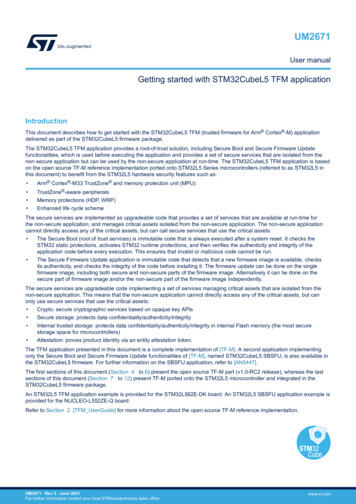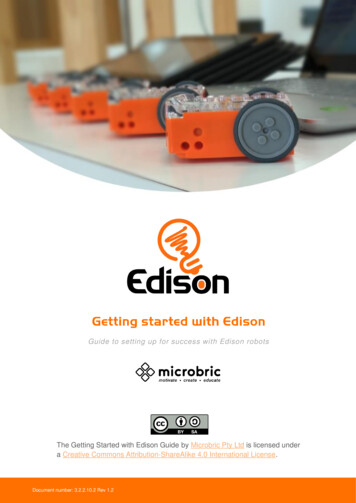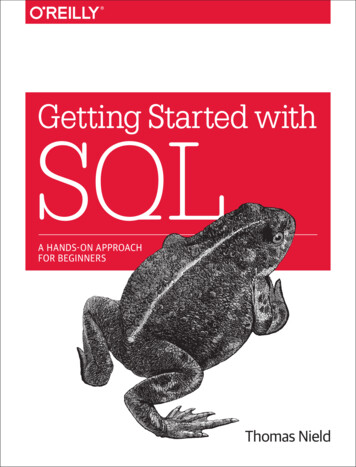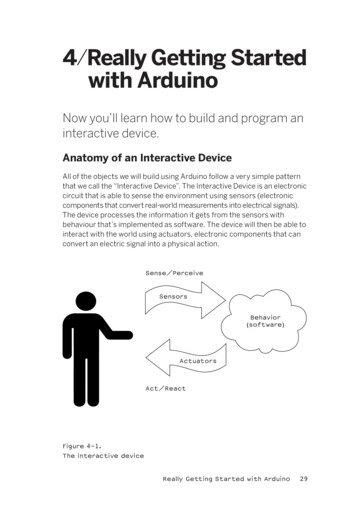
Transcription
UM2671User manualGetting started with STM32CubeL5 TFM applicationIntroductionThis document describes how to get started with the STM32CubeL5 TFM (trusted firmware for Arm Cortex -M) applicationdelivered as part of the STM32CubeL5 firmware package.The STM32CubeL5 TFM application provides a root-of-trust solution, including Secure Boot and Secure Firmware Updatefunctionalities, which is used before executing the application and provides a set of secure services that are isolated from thenon‑secure application but can be used by the non-secure application at run-time. The STM32CubeL5 TFM application is basedon the open source TF-M reference implementation ported onto STM32L5 Series microcontrollers (referred to as STM32L5 inthis document) to benefit from the STM32L5 hardware security features such as: Arm Cortex -M33 TrustZone and memory protection unit (MPU) TrustZone -aware peripheralsMemory protections (HDP, WRP)Enhanced life cycle schemeThe secure services are implemented as upgradeable code that provides a set of services that are available at run-time forthe non-secure application, and manages critical assets isolated from the non-secure application. The non-secure applicationcannot directly access any of the critical assets, but can call secure services that use the critical assets: The Secure Boot (root of trust services) is immutable code that is always executed after a system reset. It checks theSTM32 static protections, activates STM32 runtime protections, and then verifies the authenticity and integrity of theapplication code before every execution. This ensures that invalid or malicious code cannot be run. The Secure Firmware Update application is immutable code that detects that a new firmware image is available, checksits authenticity, and checks the integrity of the code before installing it. The firmware update can be done on the singlefirmware image, including both secure and non-secure parts of the firmware image. Alternatively it can be done on thesecure part of firmware image and/or the non-secure part of the firmware image independently.The secure services are upgradeable code implementing a set of services managing critical assets that are isolated from thenon-secure application. This means that the non-secure application cannot directly access any of the critical assets, but canonly use secure services that use the critical assets: Crypto: secure cryptographic services based on opaque key APIs Secure storage: protects data confidentiality/authenticity/integrity Internal trusted storage: protects data confidentiality/authenticity/integrity in internal Flash memory (the most securestorage space for microcontrollers) Attestation: proves product identity via an entity attestation token.The TFM application presented in this document is a complete implementation of [TF-M]. A second application implementingonly the Secure Boot and Secure Firmware Update functionalities of [TF-M], named STM32CubeL5 SBSFU, is also available inthe STM32CubeL5 firmware. For further information on the SBSFU application, refer to [AN5447].The first sections of this document (Section 4 to 6) present the open source TF-M part (v1.0-RC2 release), whereas the lastsections of this document (Section 7 to 12) present TF-M ported onto the STM32L5 microcontroller and integrated in theSTM32CubeL5 firmware package.An STM32L5 TFM application example is provided for the STM32L562E-DK board. An STM32L5 SBSFU application example isprovided for the NUCLEO-L552ZE-Q board.Refer to Section 2 [TFM UserGuide] for more information about the open source TF-M reference implementation.UM2671 - Rev 3 - June 2021For further information contact your local STMicroelectronics sales office.www.st.com
UM2671General information1General informationThe STM32CubeL5 TFM application runs on STM32L5 series 32-bit microcontrollers based on the Arm Cortex ‑M processor.Note:Arm is a registered trademark of Arm Limited (or its subsidiaries) in the US and/or elsewhere.Table 1 presents the definition of acronyms that are relevant for a better understanding of this document.Table 1. List of acronymsAcronymUM2671 - Rev 3DescriptionAEADAuthenticated encryption with associated dataAESAdvanced encryption standardCLICommand line interfaceCTRCounter mode, a cryptographic mode of operation for block ciphersEATEntity attestation tokenECDSAElliptic curve digital signature algorithm. Asymmetric cryptography.ECIESElliptic curve integrated encryption schemeGUIGraphic user interfaceHDPSecure hide protectionHUKHardware unique keyIATInitial attestationIPCInter process communicationITSInternal storage service. Internal storage service provided by TF-M.NSPENon-secure processing environment PSA term. In TF-M this means non secure domain typically running anoperating system using services provided by TF-M.MPUMemory protection unitOAEPOptimal asymmetric encryption padding is a padding scheme often used together with RSA encryption.PSAPlatform security architecture. Framework for securing devices.RoTRoot of trustRSARivest–shamir–adleman. Asymmetric cryptography.SBSFUSecure Boot and Secure Firmware Update. In the STM32CubeL5 this is the name of the TF-M based application,with Secure Boot and Secure Firmware Update functionalities only.SFNSecure function. An entry function to a secure service. Multiple SFN per SS are permitted.SPSecure partition. A logical container for a single secure service.SPESecure processing environment PSA term. In TF-M this means the secure domain protected by TF-M.SPMSecure partition manager. The TF-M component responsible for enumeration, management and isolation ofmultiple secure partitions within the TEE.SSSecure service. A component within the TEE that is atomic from a security/trust point of view, i.e. which is viewedas a single entity from a TF-M point of view.SSTSecure storage service. Secure storage service provided by TF-M.TBSA-MTrusted base system architecture for Arm Cortex -MTFMIn the STM32CubeL5 this is the name of the TF-M based application with complete functionalities.page 2/88
UM2671General informationAcronymUM2671 - Rev 3DescriptionTF-MTrusted firmware for M-class Arm. TF-M provides a reference implementation of secure world software for Armv8M.WRPWrite protectionpage 3/88
UM2671Documents and open source software resources2Documents and open source software resourcesBelow resources are public and available either on STMicroelectronics web site at www.st.com or on third partieswebsites.Table 2. Document referencesReferenceDocument[RM0438]STM32L552xx and STM32L562xx advanced Arm -based 32-bit MCUs - Reference Manual(1)[UM2237]STM32CubeProgrammer software description - User manual(1)[UM2553]STM32CubeIDE quick start guide - User manual(1)[AN4992]Overview secure firmware install (SFI) - Application note(1)[AN5156]Introduction to STM32 microcontrollers security - Application note(1)[AN5447]Overview of Secure Boot and Secure Firmware Update solution on Arm TrustZone STM32L5 Series microcontrollers - Application note(1)[PSA API]PSA developer APIs - ent(2)[RFC7049]Concise binary object representation (CBOR) R object signing and encryption (COSE) https://tools.ietf.org/html/rfc8152(2)1. Available at www.st.com. Contact STMicroelectronics when more information is needed.2. This URL belongs to a third party. It is active at document publication, however STMicroelectronics shall not be liable for anychange, move or inactivation of the URL or the referenced material.Table 3. Open source software resourcesReferenceOpen source software resource[TF-M]TF-M (Trusted firmware-M) Arm driven open source software framework t open source software http://mcuboot.com/(1)[MbedCrypto]MbedCrypto open source software https://github.com/ARMmbed/mbed-crypto(1)[PSA]PSA certification website: www.psacertified.org(1)1. This URL belongs to a third party. It is active at document publication, however STMicroelectronics shall not be liable for anychange, move or inactivation of the URL or the referenced material.UM2671 - Rev 3page 4/88
UM2671STM32Cube overview3STM32Cube overviewSTM32Cube is a STMicroelectronics original initiative to significantly improve designer's productivity by reducingdevelopment effort, time and cost. STM32Cube covers the whole STM32 portfolio.STM32Cube includes: A set of user-friendly software development tools to cover project development from the conception to therealization, among which:–STM32CubeMX, a graphical software configuration tool that allows the automatic generation of Cinitialization code using graphical wizards–STM32CubeIDE, an all-in-one development tool with peripheral configuration, code generation, codecompilation, and debug features–STM32CubeProgrammer (STM32CubeProg), a programming tool available in graphical and commandline versions–STM32CubeMonitor-Power (STM32CubeMonPwr), a monitoring tool to measure and help in theoptimization of the power consumption of the MCU STM32Cube MCU & MPU Packages, comprehensive embedded-software platforms specific to eachmicrocontroller and microprocessor series (such as STM32CubeL5 for the STM32L5 Series), which include:–STM32Cube hardware abstraction layer (HAL), ensuring maximized portability across the STM32portfolio–STM32Cube low-layer APIs, ensuring the best performance and footprints with a high degree of usercontrol over the hardware–A consistent set of middleware components such as FAT file system, RTOS, USB host and device,TCP/IP, touch library, and graphics–All embedded software utilities with full sets of peripheral and applicative examples STM32Cube expansion packages, which contain embedded software components that complement thefunctionalities of the STM32Cube MCU and MPU packages with:–Middleware extensions and applicative layers–Examples running on some specific STMicroelectronics development boardsUM2671 - Rev 3page 5/88
UM2671Arm trusted firmware-M (TF-M) introduction4Arm trusted firmware-M (TF-M) introduction[TF-M] (Trusted Firmware-M) is an Arm driven open source software framework providing a referenceimplementation of PSA standard on Cortex -M33 (TrustZone ) core: PSA immutable RoT (root of trust): immutable “Secure Boot & Secure Firmware Update” application (namedTFM SBSFU Boot) executed after any reset. This application is based on [MCUboot] open source software PSA updatable RoT: “secure” application (named TFM Appli/Secure) that implements a set of secureservices that are isolated in the secure/privileged environment and that can be called by the non-secureapplication at non-secure application run time via the PSA APIs:–Secure storage service: TF-M secure storage (SST) service implements PSA Protected StorageAPIs that can encrypt data and write the result in possibly an untrusted storage. The SST serviceimplements an AES-GCM based AEAD encryption policy, as a reference, to protect data integrity andauthenticity.–Internal trusted storage service: TF-M internal trusted storage (ITS) service implements PSA internaltrusted storage APIs that can write data in a microcontroller built in Flash memory region that isisolated from non-secure or from unprivileged applications thanks to the hardware security protectionmechanisms.–Cryptography service: TF-M crypto service implements the PSA crypto APIs that allow application touse cryptography primitives such as symmetric and asymmetric ciphers, hash, message authenticationcodes (MACs) and authenticated encryption with associated data (AEAD). It is based on [MbedCrypto]open source software–Initial attestation service: TF-M Initial Attestation Service allows the application to prove the deviceidentity during an authentication process to a verification entity. The initial attestation service can createa token on request, which contains a fix set of device specific data. Application updatable RoT: third party secure services (to be implemented in TFM Appli/Secure application)that are isolated in the secure/unprivileged environment and that can be called by the non-secure applicationat non-secure application run time:Figure 1. TF-M overviewIsolation: privileged/unprivilegedOSPSA APITF-M core (IPC, SPM, interrupt handling)Platform drivers(Crypto,NONCE,RNG etc.)Initial attestationMiddlewareCryptographyNetworkSecure storage3rd partyAppsInternal trustedstorageSecureNon-secureMCU bootIsolation boundaryTF-MPSA updatableRoTPSA immutableRoTApplication updatableRoTTBSA-M hardware (SoC)Isolation secure/non-secureUM2671 - Rev 3page 6/88
UM2671Secure Boot and Secure Firmware Update services (PSA immutable RoT)5Secure Boot and Secure Firmware Update services (PSA immutableRoT)5.1Product security introductionA device deployed in the field operates in an untrusted environment and it is therefore subject to threats andattacks. To mitigate the risk of attack, the goal is to allow only authentic firmware to run on the device. Infact, allowing the update of firmware images to fix bugs, or introduce new features or countermeasures, iscommonplace for connected devices, but it is prone to attacks if not executed in a secure way.Consequences may be damaging such as firmware cloning, malicious software download or device corruption.Security solutions must be designed in order to protect sensitive data (potentially even the firmware itself) andcritical operations.Typical countermeasures are based on cryptography (with associated key) and on memory protections: Cryptography ensures integrity (the assurance that data has not been corrupted), authentication (theassurance that a certain entity is who it claims to be) and confidentiality (the assurance that only authorizedusers can read sensitive data) during firmware transfer. Memory protection mechanisms prevent external attacks (for example by accessing the device physicallythrough JTAG) and internal attacks from other embedded non-secure processes.The following chapters describe solutions implementing integrity and authentication services to address the mostcommon threats for an IoT end-node device.5.2Secure BootSecure Boot (SB) asserts the integrity and authenticity of the user application image that is executed:cryptographic checks are used in order to prevent any unauthorized or maliciously modified software fromrunning. The Secure Boot process implements a root of trust: starting from this trusted component (step 1 onFigure 2), every other component is authenticated (step 2 on Figure 2) before its execution (step 3 on Figure 2).Integrity is verified so as to be sure that the image that is going to be executed has not been corrupted ormaliciously modified.Authenticity check aims to verify that the firmware image is coming from a trusted and known source in order toprevent unauthorized entities to install and execute code.Figure 2. Secure Boot root of trustResetCode2CodeAuthenticates3ApplicationSecure BootTrustedUM2671 - Rev 31page 7/88
UM2671Secure Firmware Update5.3Secure Firmware UpdateSecure Firmware Update (SFU) provides a secure implementation of in-field firmware updates, enabling thedownload of new firmware images to a device in a secure way.As shown in Figure 3, two entities are typically involved in a firmware update process: Server–OEM manufacturer server / web service–Stores the new version of device firmware–Communicates with the device and sends the new image version in an encrypted form if it is available Device–Deployed in the field–Embeds a code running firmware update process.–Communicates with the server and receives a new firmware image.–Authenticates, decrypts and installs the new firmware image and executes it.Figure 3. Typical in-field device update scenarioIn-field deviceEncrypted Firmware1STM32Server2Communication channelTFMSBSFUBoot3FirmwareFirmware update runs through the following steps:1.If a firmware update is needed, a new encrypted firmware image is created and stored in the server.2.The new encrypted firmware image is sent to the device deployed in the field through an untrusted channel.3.The new image is downloaded, checked and installed.Firmware update is done on the complete firmware image.Firmware update is vulnerable to the threats presented in Section 5.1 Product security introduction: cryptographyis used to ensure confidentiality, integrity and authentication.Confidentiality is implemented to protect the firmware image, which may be a key asset for the manufacturer.The firmware image sent over the untrusted channel is encrypted so that only devices having access to theencryption key can decrypt the firmware package.Integrity is verified to be sure that the received image is not corrupted.Authenticity check aims to verify that the firmware image is coming from a trusted and known source, in order toprevent unauthorized entities to install and execute code.5.4Cryptography operationsTFM SBSFU Boot application example is delivered with configurable cryptographic schemes (solution forfirmware authentication and firmware encryption): RSA-2048 asymmetric cryptography for image authenticity verification, AES-CTR-128 symmetriccryptography with key RSA-OAEP encrypted for image confidentiality, and SHA 256 cryptography for imageintegrity check. RSA-3072 asymmetric cryptography for image authenticity verification, AES-CTR-128 symmetriccryptography with key RSA-OAEP encrypted for image confidentiality, and SHA 256 cryptography for imageintegrity check.UM2671 - Rev 3page 8/88
UM2671Cryptography operations ECDSA-256 asymmetric cryptography for image authenticity verification, AES-CTR-128 symmetriccryptography with key ECIES-P256 encrypted for image confidentiality, and SHA 256 cryptography for imageintegrity check.For more information on the cryptographic scheme, please refer to [MCUboot] open source website.UM2671 - Rev 3page 9/88
UM2671Secure services at run time6Secure services at run timeSecure services at run time are a set of services, that can be called at non-secure application run-time, thatmanage critical assets that are isolated from the non-secure application. non-secure application cannot accessdirectly to any of the critical assets but can only use secure services that use the critical assets. Secure servicesare provided with two levels of isolation thanks to privileged/unprivileged mode usage (the processor can limit orexclude access to some resources by executing code in privileged or unprivileged mode): Privileged secure services: secure services executed in privileged mode. Such type of services can accessany assets in the system (secure or non-secure, privileged or unprivileged). These services are in PSAupdatable RoT partition: secure storage service, internal trusted storage service, secure cryptographicservice and initial attestation service. Unprivileged secure services: secure services executed in unprivileged mode. Such type of services canaccess any assets in the system except the assets stored in privileged area. These services are inapplication updatable RoT partition: 3rd party service.6.1Secure storage service (SST)TF-M secure storage (SST) service implements PSA protected storage APIs (refer to [PSA API] for moreinformation).The service is backed by hardware isolation of the flash access domain and, in the current version, relies onhardware to isolate the flash area from non-secure access.The current SST service design relies on hardware abstraction level provided by TF-M. The SST service providesa non-hierarchical storage model, as a filesystem, where all the assets are managed by linearly indexed list ofmetadata.The SST service implements an AES-GCM based AEAD encryption policy, as a reference, to protect dataconfidentiality, integrity and authenticity.The design addresses the following high-level requirements as well: Confidentiality - Resistance to unauthorized accesses through hardware/software attacks. Access Authentication - Mechanism to establish requester’s identity (a non-secure entity, secure entity, or aremote server). Integrity - Resistant to tampering by either the normal users of a product, package, or system or others withphysical access to it. If the content of the secure storage is changed maliciously, the service is able to detectit. Reliability - Resistant to power failure scenarios and incomplete write cycles. Configurability - High level configurability to scale up/down memory footprint to cater for a variety of deviceswith varying security requirements. Performance - Optimized to be used for resource constrained devices with very small silicon footprint, thePPA (power, performance, area) should be optimal.For more information about hardware isolation mechanism, refer to Section 7 Protection measures and securitystrategy.6.2Internal trusted storage service (ITS)TF-M internal trusted storage (ITS) service implements PSA internal trusted storage APIs (for more information,please refer to [PSA API]).The service is backed by hardware isolation of the flash access domain and relies on hardware to isolate the flasharea from non-secure access and application updatable RoT at higher levels of isolation.Contrary to SST service, the ITS service does not implement any encryption policy, the confidentiality of databeing ensured thanks to hardware isolation of the internal Flash memory access domain.The current ITS service design relies on hardware abstraction provided by TF-M. The ITS service provides anon-hierarchical storage model, as a filesystem, where all the assets are managed by a linearly indexed list ofmetadata.UM2671 - Rev 3page 10/88
UM2671Secure cryptographic serviceThe design addresses the following high-level requirements as well: Confidentiality - resistance to unauthorized accesses through hardware/software attacks, thanks to hardwareisolation of the flash access domain Access authentication - mechanism to establish requester’s identity (a non-secure entity, secure entity, or aremote server). Integrity - resistance to tampering by attackers with physical access is provided by the internal flash deviceitself, while resistance to tampering by non-secure or application updatable RoT attackers is provided byhardware isolation mechanism. Reliability - resistance to power failure scenarios and incomplete write cycles. Configurability - high level of configurability to scale up/down memory footprint to cater for a variety ofdevices with varying requirements.For more information about hardware isolation mechanism, refer to Section 7 Protection measures and securitystrategy.6.3Secure cryptographic serviceThe TF-M crypto service provides an implementation of the PSA crypto API in a PSA updatable RoT securepartition in TF-M. It is based on mbed-crypto, which is a reference implementation of the PSA crypto API. Formore details on the PSA crypto API or the mbed-crypto implementation, refer directly to the [MbedCrypto] GitHubrepository.The service can be used by other services running in the secure processing environment (SPE), or byapplications running in the non-secure processing environment (NSPE), to provide cryptographic functionalities.6.4Initial attestation serviceTF-M Initial Attestation Service allows the application to prove the device identity during an authentication processto a verification entity. The initial attestation service can create an entity attestation token (EAT) on request, whichcontains a fix set of device specific data. Device must contain an attestation key pair, which is unique per device.The token is signed with the private part of attestation key pair. The public part of the key pair is known by theverification entity. The public key is used to verify the token authenticity. The data items in the token used to verifythe device integrity and assess its trustworthiness. Attestation key provisioning is out of scope for the attestationservice and is expected to take part during manufacturing of the product.UM2671 - Rev 3page 11/88
UM2671Protection measures and security strategy7Protection measures and security strategyCryptography ensures integrity, authentication and confidentiality. However, the use of cryptography alone is notenough: a set of measures and system-level strategy are needed for protecting critical operations, sensitive data(such as a secret key), and the execution flow, in order to resist possible attacks. Refer to [AN5156] to get moredetails about hardware security peripherals integrated in STM32L5 microcontroller.The STM32CubeL5 TFM example uses a security strategy based on the following concepts: Ensure single-entry point at reset: force code execution to start with Secure Boot code Make TFM SBSFU Boot code and TFM SBSFU Boot “secrets” immutable: no possibility to modify or alterthem once security is fully activated Create 3 protected/isolated domains:–Secure / privileged: to execute PSA immutable RoT code using its associated secrets and to usesecure privileged STM32L5 peripherals. This domain is hidden once immutable PSA RoT codeexecution is completed.–Secure / privileged: to execute PSA updatable RoT using its associated secrets and to use secureprivileged STM32L5 peripherals.–Secure / unprivileged: to execute application updatable RoT and its associated secrets and to usesecure unprivileged STM32L5 peripherals. Limit execution surface according to application state:–From product reset till installed application is verified: only TFM SBSFU Boot code execution allowed–Once installed application is verified OK: application code (secure part and non-secure part) executionallowed Remove JTAG access to secure part of the device.Figure 4 gives a high-level view of the security mechanisms activated on STM32L5 Series.Figure 4. TFM application using STM32L5 security peripheralsSecure FunctionsImmutable PSA RoTUnique boot entrySecure bootRoot of trustBOOT LockHUK (hardware unique key)Initial attestation infoSecure firmware updateWRPCrypto keyRSA public keyCrypto operationsMbedTLS software cryptocombined with SHA256hardwareFirmware images managementPSA updatable RoTAnti rollback countersDedicated Flash memory sectorsnever erasedSecure partitioningPSA RoT isolationTZ MPUSecure crypto servicesKeys value correlationCrypto operationsSecure storageEncryption keyInternal trusted storageNVM data storageInitial attestationApplication updatable RoTInitial attestation tokenNo service**No application updatable RoT service implemented in the TFM exampleUM2671 - Rev 3Mbed software crypto combinedwith ECC/SHA256/AEShardwarePrivate keyRTC backup ked”TZ(secure)RDPL1**“WRP & Locked”Secure SRAM2Other infos“WRP &Locked”Secure SRAM2“Locked“ MPU (non-privilege)**RDP level 1 is the minimum for PSA L2 certificationpage 12/88
UM2671Protections against outer attacks7.1Protections against outer attacksOuter attacks refer to attacks triggered by external tools such as debuggers or probes, trying to access thedevice. In the TFM SBSFU Boot application example, device lifecycle (managed through RDP option bytes),boot lock and protected SRAM2 protections are used to protect product against outer attacks: Device lifecycle: read protection level 1 is used to ensure that JTAG debugger cannot access any secure orprotected part of the device:–secure JTAG debug forbidden–protected memory access forbidden (Flash memory, SRAM2 and back-up registers).–JTAG can only access the non-secure SRAM1 and all non-secure peripheral registers. Boot lock: BOOT LOCK option byte is used to fix the entry point to a memory location defined in the Optionbyte. In TFM application example, boot Entry point after reset is fixed on TFM SBSFU Boot code. Protected SRAM2: SRAM2 is automatically protected against intrusion once system is configured in RDPlevel 1. SRAM2 content is erased as soon as an intrusion is detected. Moreover, SRAM2 content can bewrite protected (content is frozen but can be read) until next reset by activating lock bit. In TFM applicationexample, system has been configured to use the protected SRAM2 to share and to freeze HUK and initialattestation information between TFM SBSFU Boot application and secure application.Other STM32L5 peripherals could be used to protect product against outer attacks, but current TFM exampledoes not use them: Anti-tamper: the anti-tamper protection could be used to detect physical tampering actions on the deviceand to take related counter measures. In case of tampering detection, the TFM SBSFU Boot could force areboot. Debug: the debug protection consists in de-activating the DAP (Debug Access Port). Once de-activated,JTAG pins are no longer connected to the STM32 internal bus. DAP is automatically disabled with RDPlevel 2. Watchdog IWDG (independent watchdog) is a free-running down-counter. Once running, it cannot bestopped. It must be refreshed periodically before it causes a reset. This mechanism could be used to controlthe TFM SBSFU Boot execution duration.7.2Protections against inner attacksInner attacks refer to attacks triggered by code running into the STM32. Attacks may be due to either maliciousfirmware exploiting bugs or security breaches, or unwanted operations. In the TFM application example, TZ(TrustZone ), MPU (memory protection unit), SAU (security attribution unit), GTZC (global TrustZone controller),WRP (write protect), and HDP (hide protection) protections preserve the product from inner attacks: TZ, secure MPU and GTZC are combined to put in place different protected environments with differentprivileges and different access rights:––––TZ: Cortex -M33 CPU core supports 2 modes of operation (secure and non-secure). When Cortex M33 is in non-secure mode it cannot access any SMT32L5 resources configured in secure.MPU: The MPU is a memory protection mechanism that allows specific access rights to be definedfor any memory mapped resource of the device: Flash memory, SRAM and peripheral registers. MPUattribu
Getting started with STM32CubeL5 TFM application UM2671 User manual UM2671 - Rev 3 - June 2021 For further information contact your local STMicroelectronics sales office. www.st.com [TF-M] [TF-M] [AN5










